
PROGRAM NOTES
Sounds from Arabia: Arab Music from the Saudi Ensemble
Listen Now
download
Subscribe (itunes)
Subscribe (rss)
help
Program
Sounds from Arabia: Arab Music from the Saudi Ensemble
The Saudi Ensemble
Khalid Al-Barak, director
Abo Al-Hashmi Khaleafah, nay (flute)
Abdeen Shareef, semsemyah (lyre) and
Mohammad Sultan, ‘ud (lute)
Abdullah Khateri, qanun (plucked zither)
Adel Adbul Dayem, violin
Mosa Al-Rofai, tabla (drum)
| Title | Track |
|---|---|
| Fisalam al-Kayala This traditional melody comes from a love song that expresses sad and wistful feelings upon the departure of a loved one. The maqam (melodic mode) is called bayati, a C-major scale with a half-flat E and a half-sharp F. |
0:00-3:10 |
| Ya Reem This song dates to the mid-twentieth century and originates from western Saudi Arabia (Jeddah). The maqam (melodic mode) is called bayati, and the title is a woman’s name. |
3:20-7:47 |
Suwya’at Al ‘aseel |
7:52-13:30 |
| Gharamak In coastal areas, this music is played among sailors while fishing or to celebrate their return home. The title, Gharamak, means “romance.” It features the traditional lyre (semsemyah), one of the world’s oldest musical instruments. |
13:35-18:30 |
Taqsim on qanun and nay |
18:35-23:45 |
Irsil salami |
23:45-29:05 |
Arus al Rawed |
29:09-33:18 |
The Mal’am |
33:26-37:28 |
| Taqsim for violin See notes under track number 5. |
37:35-39:05 |
| Ghali Alathman This modern tune, from the early 1990s, is heard all over Saudi Arabia. |
39:10-45:47 |
Ashiqta |
45:52-49:35 |
| Gideemak nideemak This early twentieth-century song from Hejaz is titled, “The past will always be with you.” |
49:44-53:41 |
Anu wa al habib |
53:48-58:46 |
Taqsim for ‘ud and qanun |
58:55-1:03:45 |
Methal sibiq |
1:03:49-1:08:03 |
Watani habib |
1:08:12-1:12:27 |
Listen Now
download
Subscribe (itunes)
Subscribe (rss)
help
Listen Now
download
Subscribe (itunes)
Subscribe (rss)
help
Performers
The Saudi Music Ensemble is based in Jeddah, Saudi Arabia, and is supported by the Saudi Ministry of Culture and Information. In addition to its US visit in 2012, the ensemble has toured Central Asia, the Caucasus, South America, Korea, and China.
The Saudi Ensemble
Khalid Al-Barak, director
Abo Al-Hashmi Khaleafah, nay (flute)
Abdeen Shareef, semsemyah (lyre) and percussion
Mohammad Sultan, ‘ud (lute)
Abdullah Khateri, qanun (plucked zither)
Adel Adbul Dayem, violin
Mosa Al-Rofai, tabla (drum)
Listen Now
download
Subscribe (itunes)
Subscribe (rss)
help
Related Images
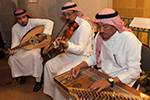
Left to right: Members of the Saudi Ensemble perform at the Sackler Gallery in November 2012 on ud (lute), violin, and qanun (zither). Pictured are Mohammad Sultan, ‘ud; Adel Adbul Dayem, violin; and Abdullah Khateri, qanun.
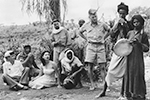
In 2014–15, the Sackler presented the exhibition Unearthing Arabia: The Archaeological Adventures of Wendell Phillips. During his excavations in modern-day Yemen in 1950 and 1951, Phillips (far left) and members of the expedition team were photographed listening to local musicians (on frame drum, far right, and probably double-reed, second from right). In addition to truckloads of excavation equipment, his caravan carried a battery-operated reel-to-reel tape recorder that they used to record Arab and Gypsy musicians. Photo courtesy of the American Foundation for the Study of Man.
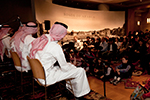
The Saudi Ensemble performs at the exhibition Roads of Arabia at the Arthur M. Sackler Gallery in November 2012.
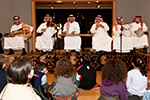
Members of the Saudi Ensemble perform at the Sackler Gallery in November 2012, in conjunction with the exhibition Roads of Arabia. Left to right: Abdeen Shareef, ‘ud (lute); Adel Adbul Dayem, violin; Abdullah Khateri, qanun (plucked zither); Abo Al-Hashmi Khaleafah, nay (flute); Mosa Al-Rofai and Mohammad Sultan, percussion.
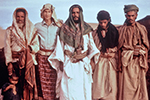
Archaeologist Wendell Phillips was an amateur jazz musician. During his excavations of South Arabia in the early 1950s, he played recordings for his Arab hosts of jazz clarinetist Benny Goodman, drummer Gene Krupa, and vibraphonist Lionel Hampton. Here, Phillips (third from left) poses with Yemeni men, including Sheik Al-Barhi (center), a leader of the Bal Harith tribe, and a child. Photo courtesy of the American Foundation for the Study of Man.

Wendell Phillips and his archaeological team encountered these Gypsy dancers in South Arabia in the early 1950s. Qataban and Sheba (1955), his book about his adventures, provides a detailed account of a performance by Gypsy musicians and dancers.
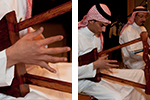
One of the world’s oldest instruments is the Middle Eastern lyre, called in Saudi Arabia the semsemyah. Here, it is played by Abdeen Shareef of the Saudi Ensemble at the Sackler Gallery in November 2012.
Listen Now
download
Subscribe (itunes)
Subscribe (rss)
help
The Credits
Podcast coordination by Michael Wilpers, F|S manager of performing arts. Thanks to Halah Nasser for consulting on the titles and translations of songs, SuMo Productions for audio editing, Joelle Seligson for text editing, Torie Castiello Ketcham for web design, Neil Greentree for photography, and especially the Saudi Ensemble for granting permission to share their performance at the Freer Gallery. This podcast was funded in part through the exhibition Unearthing Arabia: The Archaeological Adventures of Wendell Phillips, on view at the Sackler Gallery from October 11, 2014, through June 7, 2015. The performance was presented in conjunction with the exhibition Roads of Arabia: Archaeology and History of the Kingdom of Saudi Arabia.
Podcast Series
Concerts
Storytelling
Lectures
Subscribe to this Series
 RSS
RSS iTunes
iTunes
About Podcasts
About podcasting and how to get started
![]() Tell us what you think
Tell us what you think
Radio Asia
Explore music from all across Asia with Radio Asia, a stream of complete tracks from the collections of Smithsonian Global Sound
Most Recent Podcasts
Musicians from Marlboro IMusic of Toru Takemitsu and Tan Dun: Ralph Van Raat, piano
The Legacy of Yatsuhashi
The Traveler’s Ear: Scenes from Music
Western Music in Meiji Japan: Gilles Vonsattel, piano
Western Music in Meiji Japan
The Art of Afghan Music
Painting with Music: Bell Yung, qin
Sounds from Arabia
Tarek Yamani Trio